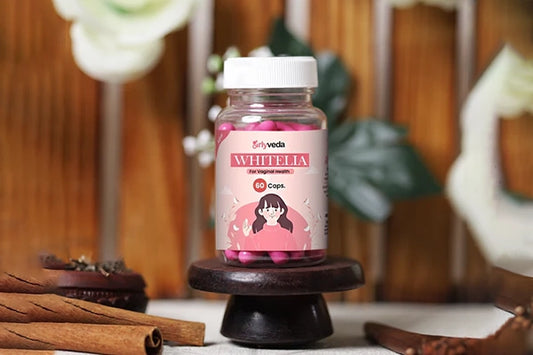White Discharge in Women: Symptoms and Prevention

White discharge in women, also known as leucorrhoea, is a common phenomenon experienced by many women during, before, or after their menstrual cycle. In this condition, our vagina produces a white or colorless sticky liquid. While this condition is a normal part of a menstrual cycle, understanding its symptoms and prevention is necessary to maintain your reproductive health. In this blog, we will discuss white discharge, what it signifies when to seek help, and how to manage it effectively.
What is Why Discharge?
White discharge, or vaginal discharge, is the name for the fluid or mucus discharge by our vagina from time to time. This is a self-cleaning process done by our vagina, uterus, and cervix to flush out dead cells and bacteria from the vagina. This process helps clean the vagina and keep it away from any infection or other issues. A little bit of white discharge is common, and it can vary in terms of colour, consistency, and odour, but if the colour, consistency, or smell is different from usual, accompanied by itching or burning, then it may indicate infection or any other reproductive health issues.
Types of White Discharge
Written below are the common types of white discharge in women and what it may indicate.
|
Types of Discharge |
Indication |
|
Clear or colourless |
Normal |
|
Bloody or brown in colour |
Irregular menstrual cycle, cervical cancer or endometrial cancer |
|
Cloudy or yellow |
Gonorrhoea |
|
Yellow or greenish with a bad smell |
STD or STI caused by parasite |
|
Pink Colour |
Shedding of the lining of uterus after childbirth |
|
Thick, white, or cheesy |
Yeast infection |
|
White, grey, or yellow with bad odour |
Vaginal infection due to overgrowing of the existing bacteria |
Symptoms of Concern
Generally, white discharge is not a matter of concern, but if you observe these following changes in your vaginal discharge, that can be concerning and indicates that you need medical attention.
Itching or irritation: A continuous feeling of irritation or itching on the vaginal area can indicate a yeast infection or other type of infection that needs immediate medical help.
Bad or unusual odour: Vaginal discharge accompanied by a bad or unpleasant odour can indicate a bacterial infection known as bacterial vaginosis.
Change in colour or consistency: If you see any change in colour or consistency of your vaginal discharge, you should immediately seek medical help as it may be an indication of reproductive health issues.
Pain or discomfort: Pain during intercourse or a burning sensation during urination can signal an infection.
Bleeding: Any spotting or bleeding outside of your normal menstrual cycle can also indicate health concerns that need medical treatment.
If you experience any of the above-mentioned symptoms, you should immediately consult with a healthcare provider. They can perform some tests to diagnose any health issues and can suggest proper treatments for that.
Causes Of White Discharge (Vaginal Discharge) Or Abnormal Discharge
There are some common factors that can result in abnormal fluid discharge. Some of them are mentioned below.
Infections: Vaginal infections can change the colour or consistency of your vaginal discharge.
Hormonal imbalance: Hormonal imbalances due to medical conditions like PCOD or thyroid disorders can also lead to abnormal discharge.
Pregnancy: The consistency of discharge may also change during pregnancy due to hormonal imbalance.
Menopause: When a woman approaches menopause, she can also observe abnormal discharge.
How to Prevent White Discharge in Women?
Practice Good Hygiene.
Wash your external genital area with mild, unscented soap or genital wash and water. Avoid douching, as it can disrupt the natural balance of bacteria present in the vagina. Wear clothing that are breathable, to maintain air circulation and avoid irritation.
Avoid Irritants
Avoid products with artificial fragrance, such as fragrant soaps, tampons, and pads that can irritate the vaginal area.
Hydration and Balanced Diet
A balanced diet rich in fruits, vegetables, and whole grains helps support hormonal balance. Hydration can also help manage bodily functions.
Medication
There are some medications, such as white free capsules, that can help manage your white discharge and reduce other related issues such as itching, irritation, and foul smell.
Ayurveda
Ayurveda is the medicinal practice from ancient India that is based on the nutritional benefits of natural ingredients that can help treat diseases effectively. Ayurvedic medications such as ayurvedic medicine for white discharge, which are packed with powerful natural ingredients, can help you balance your vaginal discharge.
Conclusion
Occasional white discharge is a common part of your menstrual cycle, but it is necessary to be aware of any abnormalities in your vaginal discharge. If you see any signs of abnormality in your white discharge, immediately consult with your health care expert to seek help. You can also avoid this abnormal discharge by practicing good hygiene, avoiding irritants, consuming a balanced diet, and taking proper medications.
FAQs
What Is The Reason For White Discharge?
White discharge can result from hormonal changes, ovulation, or vaginal health.
Is It Normal To Have White Discharge?
Yes, it is normal to have white discharge as part of the menstrual cycle.
Does White Discharge Mean Pregnancy?
White discharge alone does not indicate pregnancy; it's usually linked to ovulation or other factors.
What Does Pregnancy Discharge Look Like?
Pregnancy discharge is often milky and may be thicker than usual due to increased hormones.











Thoughts on "White Discharge in Women: Symptoms and Prevention"